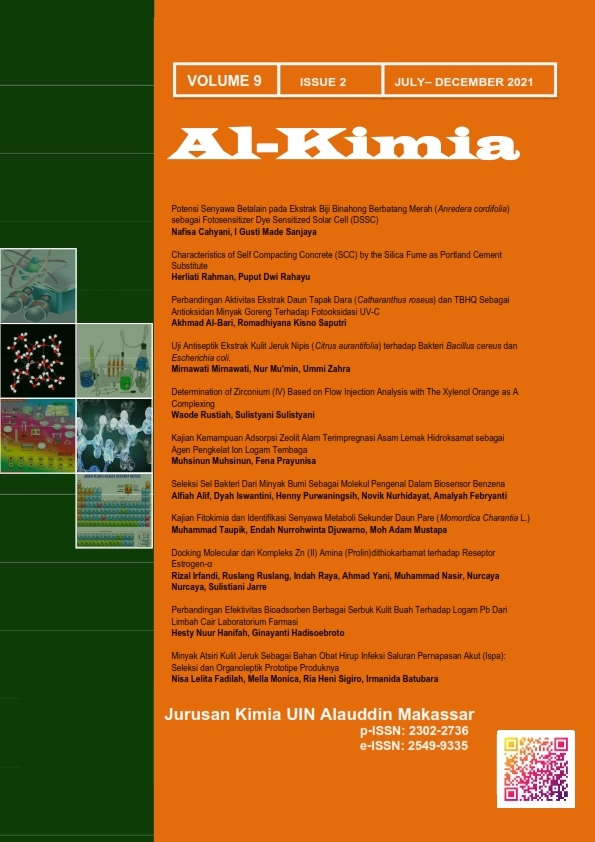Seleksi Sel Bakteri Dari Minyak Bumi Sebagai Molekul Pengenal Dalam Biosensor Benzena
Abstract
Benzene is one of the harmful compounds which can affect both healthcare and environmental quality. Conventionally the effort of detecting this compound still requires several sample pre-treatments, contributing to a long analysis time and sophisticated instrumentation. Therefore, this study was aimed to determine the potency of bacteria as the bioreceptor for detecting benzene electrochemically. The bacteria isolate was immobilized on the working electrode surface. Four bacteria isolates from the petroleum sample were evaluated. The results showed that isolate II produced high oxidation and reduction peak currents as much as 150 µA and -490 µA respectively. The selected bacteria showed characteristics to Pseudomonas sp. physiologically. Since the bacteria can degrade benzene, thus hypothetically it can produce benzene dioxygenase. Through the catechol formation, 3 mM benzene produced 108.7 µA after 11.4 s from the starting scan. This result suggested that the excreted enzyme from the selected bacteria could react with benzene enzymatically.
Downloads
References
Breed RS, Murray EGD, Smith NR. 1975. Bergey's manual of determinative bacteriology seven edition. Baltimore: Williams & Wilkins Co.
Ariyanti, Dita, Dyah Iswantini, Sugita Purwantiningsih, Novik Nurhidayat, Hefni Effendi, Ali Aulia Ghozali, and Yehezkiel Steven Kurniawan. 2020. “Highly Sensitive Phenol Biosensor Utilizing Selected Bacillus Biofilm Through an Electrochemical Method.” Makara Journal of Science 24(1). doi: 10.7454/mss.v24i1.11726.
Davey, Mary Ellen, and George A. O’toole. 2000. “Microbial Biofilms: From Ecology to Molecular Genetics.” Microbiology and Molecular Biology Reviews 64(4):847–67. doi: 10.1128/MMBR.64.4.847-867.2000.
Dawson, J. J. C., C. O. Iroegbu, H. Maciel, and G. I. Paton. 2007. “Application of Luminescent Biosensors for Monitoring the Degradation and Toxicity of BTEX Compounds in Soils.” Journal of Applied Microbiology 0(0):071008041820009-??? doi: 10.1111/j.1365-2672.2007.03552.x.
Donlan, Rodney M., and J. William Costerton. 2002. “Biofilms: Survival Mechanisms of Clinically Relevant Microorganisms.” Clinical Microbiology Reviews 15(2):167–93. doi: 10.1128/CMR.15.2.167-193.2002.
Gu, X., M. Trybiło, S. Ramsay, M. Jensen, R. Fulton, S. Rosser, and D. Gilbert. 2010. “Engineering a Novel Self-Powering Electrochemical Biosensor.” Systems and Synthetic Biology 4(3):203–14. doi: 10.1007/s11693-010-9063-2.
Iswantini, D., N. Nurhidayat, and Sarah. 2017. “Enhancing Activity and Stability of Uricase from Lactobacillus Plantarum by Zeolite Immobilization.” IOP Conference Series: Earth and Environmental Science 58:012009. doi: 10.1088/1755-1315/58/1/012009.
Iswantini, Dyah, Ali Aulia Ghozali, Cecep Kusmana, and Novik Nurhidayat. 2021. “Evaluation of Bacterial Biofilm as Biosensor for Detecting Phenol, Catechol, and 1,2-Dihydroxynaphthalene.” HAYATI Journal of Biosciences 28(4):262–70. doi: 10.4308/hjb.28.4.262-270.
Iswantini, Dyah, Novik Novik, and Trivadila Trivadila. 2011. “Glucose Biosensor Using Selected Indonesian Bacteria.” Microbiology Indonesia 5(1):9–14. doi: 10.5454/mi.5.1.2.
Kivirand, K., M. Kagan, and T. Rinke. 2013. “Calibrating Biosensors in Flow-Through Set-Ups: Studies with Glucose Optrodes.” in State of the Art in Biosensors - General Aspects, edited by T. Rinken. InTech.
Lanyon, Yvonne H., Ibtisam E. Tothill, and Marco Mascini. 2006. “An Amperometric Bacterial Biosensor Based on Gold Screen‐Printed Electrodes for the Detection of Benzene.” Analytical Letters 39(8):1669–81. doi: 10.1080/00032710600713784.
Le Digabel, Yoann, Siham Beggah, and Jan Roelof van der Meer. 2015. “Measurements of Hydrocarbon Pollutants in Aqueous Samples Using Bacterial Bioreporter Assays.” Pp. 247–57 in Hydrocarbon and Lipid Microbiology Protocols, Springer Protocols Handbooks, edited by T. J. McGenity, K. N. Timmis, and B. Nogales. Berlin, Heidelberg: Springer Berlin Heidelberg.
Merritt, Judith H., Daniel E. Kadouri, and George A. O’Toole. 2011. “Growing and Analyzing Static Biofilms.” Current Protocols in Microbiology 22(1). doi: 10.1002/9780471729259.mc01b01s22.
Moreau, J., and E. Rinnert. 2015. “Fast Identification and Quantification of BTEX Coupling by Raman Spectrometry and Chemometrics.” The Analyst 140(10):3535–42. doi: 10.1039/C5AN00035A.
Moretto, Ligia Maria, and Kurt Kalcher, eds. 2014. Environmental Analysis by Electrochemical Sensors and Biosensors: Fundamentals. New York, NY: Springer New York.
Obayori, Oluwafemi S., and Lateef B. Salam. n.d. “Degradation of Polycyclic Aromatic Hydrocarbons: Role of Plasmids.” Sci. Res. Essays 14.
Vinci, Giuliana, Marta L. Antonelli, and Raffaella Preti. 2013. “Rapid Determination of Polycyclic Aromatic Hydrocarbons in Rainwater by Liquid-Liquid Microextraction and LC with Core-Shell Particles Column and Fluorescence Detection: Liquid Chromatography.” Journal of Separation Science 36(3):461–68. doi: 10.1002/jssc.201200854.
Xu, Z., A. Mulchandani, and W. Chen. 2003. “Detection of Benzene, Toluene, Ethyl Benzene, and Xylenes (BTEX) Using Toluene Dioxygenase-Peroxidase Coupling Reactions.” Biotechnology Progress 19(6):1812–15. doi: 10.1021/bp0341794.
Zhang, Qianyu, Jiawang Ding, Lijuan Kou, and Wei Qin. 2013. “A Potentiometric Flow Biosensor Based on Ammonia-Oxidizing Bacteria for the Detection of Toxicity in Water.” Sensors 13(6):6936–45. doi: 10.3390/s130606936.
Authors who publish with this journal agree to the following terms:
1) Authors retain copyright and grant the journal right of first publication with the work simultaneously licensed under a Creative Commons Attribution License that allows others to share the work with an acknowledgement of the work's authorship and initial publication in this journal.
2) Authors are able to enter into separate, additional contractual arrangements for the non-exclusive distribution of the journal's published version of the work (e.g., post it to an institutional repository or publish it in a book), with an acknowledgement of its initial publication in this journal.
3)Authors are permitted and encouraged to post their work online (e.g., in institutional repositories or on their website) prior to and during the submission process, as it can lead to productive exchanges, as well as earlier and greater citation of published work (See The Effect of Open Access).


